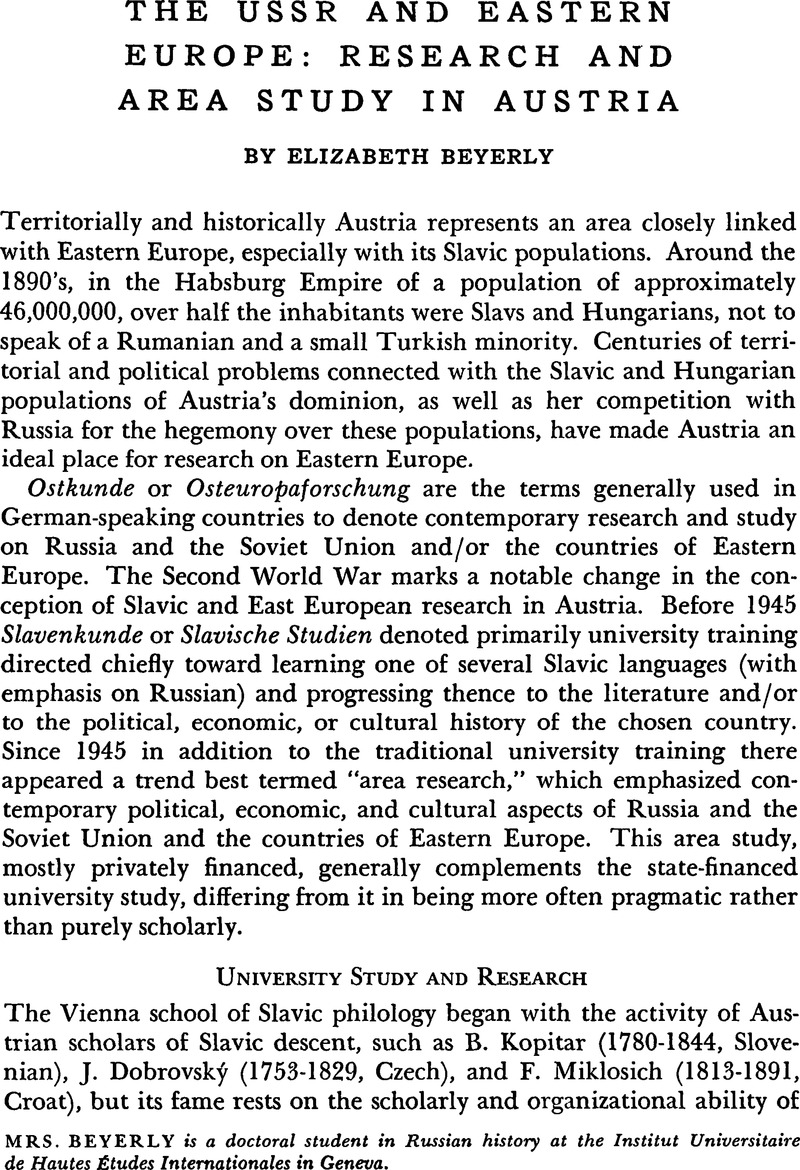No CrossRef data available.
Article contents
The USSR and Eastern Europe: Research and Area Study in Austria
Published online by Cambridge University Press: 27 January 2017
Abstract

- Type
- Notes and Comment
- Information
- Copyright
- Copyright © Association for Slavic, East European, and Eurasian Studies. 1963
References
1 For a more detailed survey on Slavic language study preparatory for the university see Schmid, A, “Der slawische Fremdsprachenunterricht in österreich,” österreichische Osthefte, No. 2, 1959, pp. 124–27Google Scholar.
2 Thorvi Eckhardt, “Zur Geschichte des Seminars für osteuropäische Geschichte der Universität Wien im ersten Jahrzehnt seines Bestandes 1907-1918 : Ausgewählte Akten und Regesten, ” in Wiener Archiv für Geschichte des Slawentums und Osteuropas, Vol. Ill : Studien zur dlteren Geschichte Osteuropas, Part II, ed. H. F. Schmid (Graz and Cologne, 1959), pp. 12-47.
3 Theodor Schiemann's scholarly activity since 1892 has made Berlin a center for historical research on Russia and the Baltic countries.
4 * G. H., “Das Institut fur osteuropäische Geschichte und Südostforschung der Universität Wien, ” Österreichische Osthefte, No. 2, 1959, pp. 118-23.
5 See Schmid, H. F., “österreichs Funktion in der Geschichte der europäischen Ostpolitik,” in Bericht über den dritten Historikertag in Graz, 26-29 Mai 1953 (Vienna, 1954), pp. 168–75 Google Scholar (“Veröffentlichungen des Verbandes österreichischer Geschichtsvereine, ” Vol. IV). Professor Schmid's untimely death in February, 1963, has deprived the world of a great Slavic scholar and beloved teacher.
6 Professor Schmid was elected, in 1960, chairman of the Comité International des Sciences Historiques; he was a member of the executive committee of the Commission Internationale des Études Slaves; and he was a member of various academies of science in both Western and Eastern Europe.
7 Bilbasov, a Russian historian (St. Petersburg), was an expert on Catherine II. His library was acquired by the Austrian ambassador to the court of Nicholas II. Jireček was the Balkan specialist in Vienna.
8 Before 1918 an agreement existed between the institute and the Institut für österreichische Geschichtsforschung, whereby the latter collected Czech and Hungarian publications, as part of materials on the Habsburg Empire.
9 Thorvi, Eckhardt, “10 Jahre Slavica-Zentralkatalog,” österreichische Osthefte, No. 2, 1962, pp. 160–63Google Scholar.
10 More on the participants and aims of this center can be found in österreichische Osthefte, No. 3, 1963, p. 266.
11 Karlheinz, Mack, “Internationale Ostsprachkurse in österreich,” österreichische Osthefte, No. 3, 1962, pp. 245–47Google Scholar.
12 Once this Zentralkatalog is completed and published, there will be a welcome public record of available Slavic journals in Austria, so far recorded only in scattered form among the Zentralkatalog neuerer ausländischer Zeitschriften und Serien in österreichischen Bibliotheken (ZAZ).
13 The AGO library has over 7, 000 maps and a rich atlas collection. See also Wilfried, Krallert, “Die Geschichte Osteuropas in kartographischer Darstellung,” Jahrbücher für Geschichte Osteuropas, III (1955), 442–59; VI (1958), 334-51Google Scholar.
14 Wiener Südostjahrbuch, 1959 , annual; österreichische Begegnung, 1959 , quarterly. Both publications contain articles on German settlements in Eastern Europe, on famous Austrians born in Eastern Europe, and so forth.
15 The university library acquires in agreement with the Institut für osteuropäische Geschichte und Südostforschung only current Polish publications and such Slavic reference materials deemed necessary for the central university library. The institute is responsible for the collecting of Slavic materials, the catalogue of which eventually will also be available in duplicate card form at the university library.
16 Stanislaus, Hafner, “Slavica der österreichischen Nationalbibliothek,” Österreichische Osthefte, No. 2, 1963, pp. 161–65Google Scholar.
17 See also Hacker, J, “Ost- und Südostforschung in österreich,” Aus Politik und Zeitgeschichte : Beilage zu “Parlament, ” Apr. 5, 1961, pp. 181–92Google Scholar, for further information.




